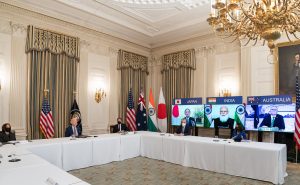The Quadrilateral Security Dialogue, otherwise known as the Quad, has become a critical component in the United States’ strategy in the Indo-Pacific since it was revived in 2017. While not a formal military alliance, its four members — Australia, India, Japan, and the United States — are powerful and influential democracies that, collectively, possess the ability to push back against China’s growing regional assertiveness.
However, at its core, Southeast Asia is a region where the forces of great power competition push against critical and deep economic linkages with both the U.S. and China, thus complicating the strategic landscape. By necessity, the Quad must navigate the resulting complex set of regional attitudes toward the China-U.S. rivalry. This makes how the group identifies its purpose a delicate, but critical, balance to strike if it wants to effectively compete with Beijing in its own backyard. The first-ever in-person Quad summit, currently scheduled for late September, following the U.N. General Assembly, provides an opportunity to develop the contours of a Quad strategy to do just that.
When the group convened in Tokyo for a ministerial meeting last October, then-U.S. Secretary of State Mike Pompeo expressed support for both institutionalizing the Quad and building out a “true security framework.” The Biden administration has so far focused more of its attention on non-security related issues – like vaccines, technology, and climate change. Now, with the Quad’s future a subject of continued debate, policymakers should look to the sentiments from across Southeast Asia for insights.
A recent influential public opinion poll of regional elites reveals that one of the greatest concerns expressed about the 10-member Association of Southeast Asian Nations (ASEAN) is that the institution “is becoming an arena of major power competition and its member states may become proxies of a major power.” When it comes to perceived challenges facing the region, respondents ranked the top three as the COVID-19 pandemic, unemployment and economic recession, and widening socioeconomic gaps and rising income disparity.
A 2020 RAND report also found that “regional countries view the United States as having more diplomatic and military influence than China, and China as having more economic influence.” While wary of China’s economic inroads, the respondents ranked economic development above security concerns and believed that China’s economic influence possessed the capacity to “weaken U.S. military influence” while no evidence suggested that U.S. military influence achieved the inverse.
What all of this suggests is that countries across Southeast Asia seek autonomy and do not wish to be pushed into choosing sides when their economic futures depend on maintaining positive ties with both powers. The Quad is currently a double-edged sword in its capacity to either assuage or accentuate these regional anxieties. Put another way, the appeal of the Quad lies in being pro-Asia, not anti-China.
This does not mean neglecting security cooperation, which is critical to regional security and stability, but is rather about maintaining the group’s main strength: its ability to bring in partners with diverse interests to pursue common objectives on an issue-by-issue basis. This means using the Quad to divide labor and harness the collective strength of its members to pursue bold vaccine, infrastructure, climate, and supply chain initiatives — all of which play into addressing the pandemic- and economic-related challenges that dominate ASEAN concerns. India, which has been resistant to focusing the group too heavily on a security agenda, would be particularly supportive of this Quad approach to the region. Focusing the majority of Quad efforts in Southeast Asia on advancing health, economic, and development goals will also make European countries more receptive to collaborating with the United States in the region. Like ASEAN states, Europeans are wary of joining any U.S. initiatives that appear to exclude or box out the Chinese.
There may come a time that requires the Quad to formally demonstrate its collective maritime power in Southeast Asia. For now, though, to push back against China’s assertive maritime behavior and territorial claims in Southeast Asia, the Quad should rely on existing arrangements, such as the annual Malabar naval exercise, and joint statements, like that made in March following the virtual leaders’ summit. If China’s maritime aggression were to expand or intensify, however, the ASEAN nations should consider supporting a formal Quad demonstration of maritime strength, like a joint Quad sail or exercise in the region.
Zack Cooper and Adam P. Liff recently argued that “China strategy should flow from regional strategy, not the other way around.” Applying this logic to the Quad means articulating and executing a strategy that delivers on the needs and concerns of Southeast Asian states. Success will contribute to a dynamic and vibrant region that can hold its own in the face of competing pressures. When one combines regional concerns over growing U.S.-China polarization and differences within the Quad itself over the pace and extent of Quad security engagement, it becomes clear that remaining flexible and focused on building out a positive agenda is critical if the Quad aims to become a partner of choice in Southeast Asia.

































